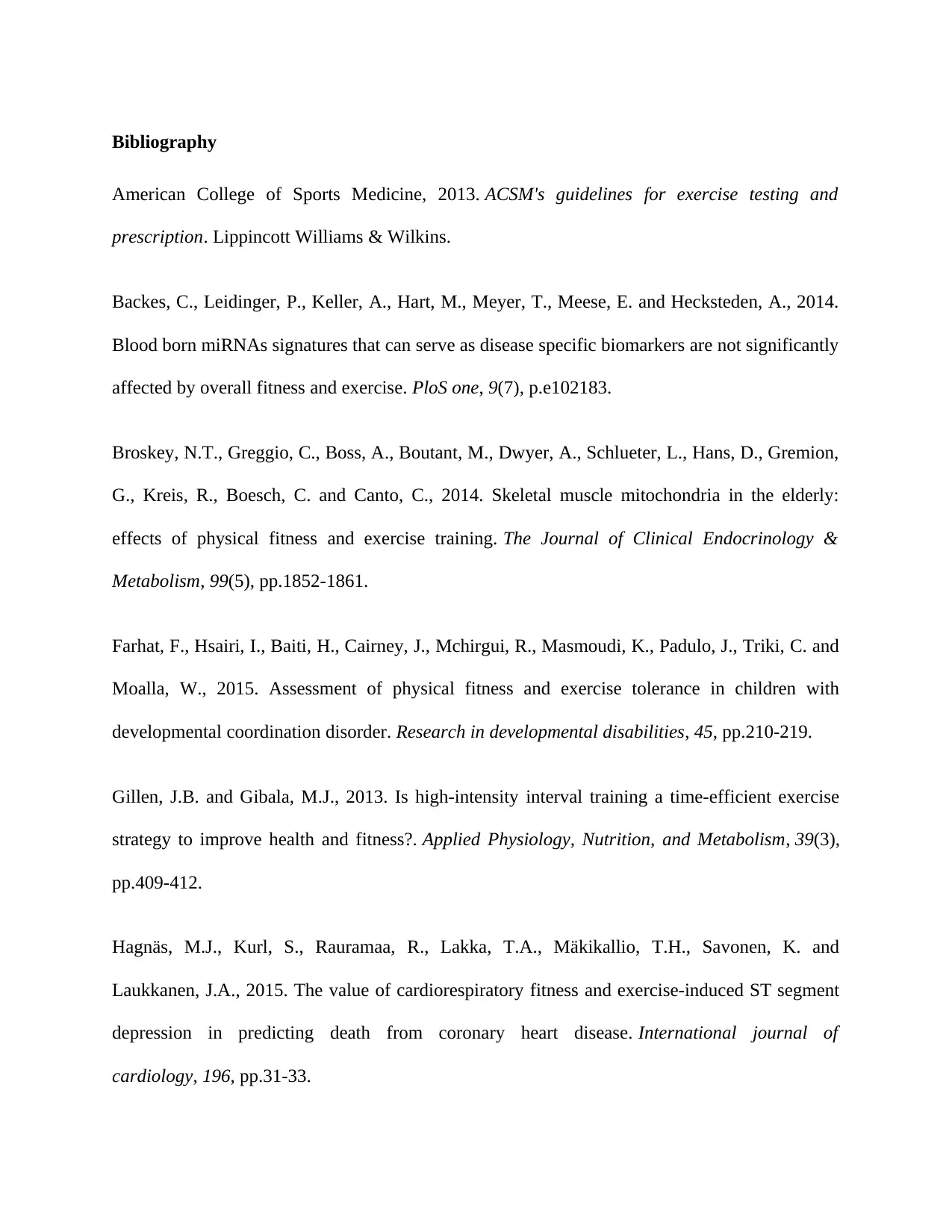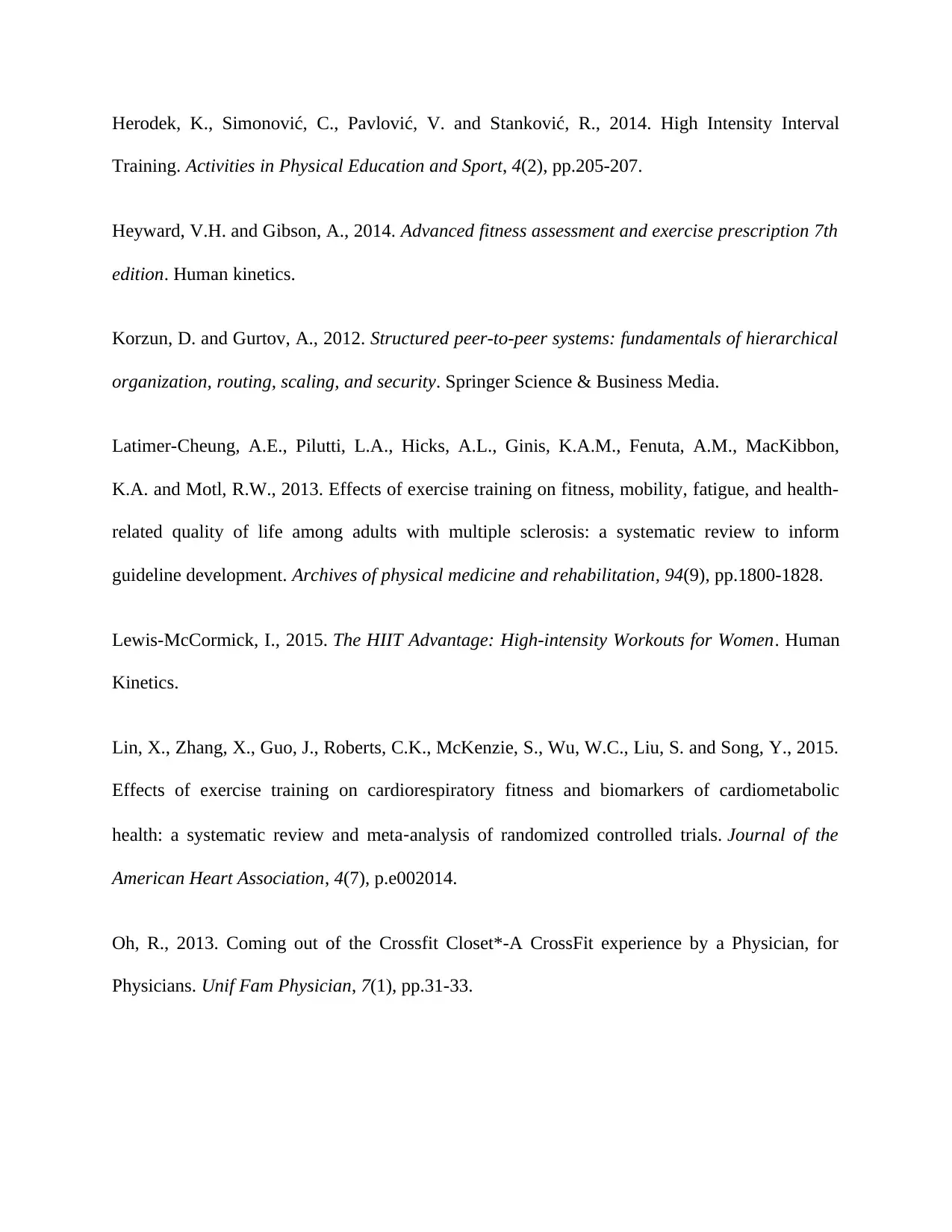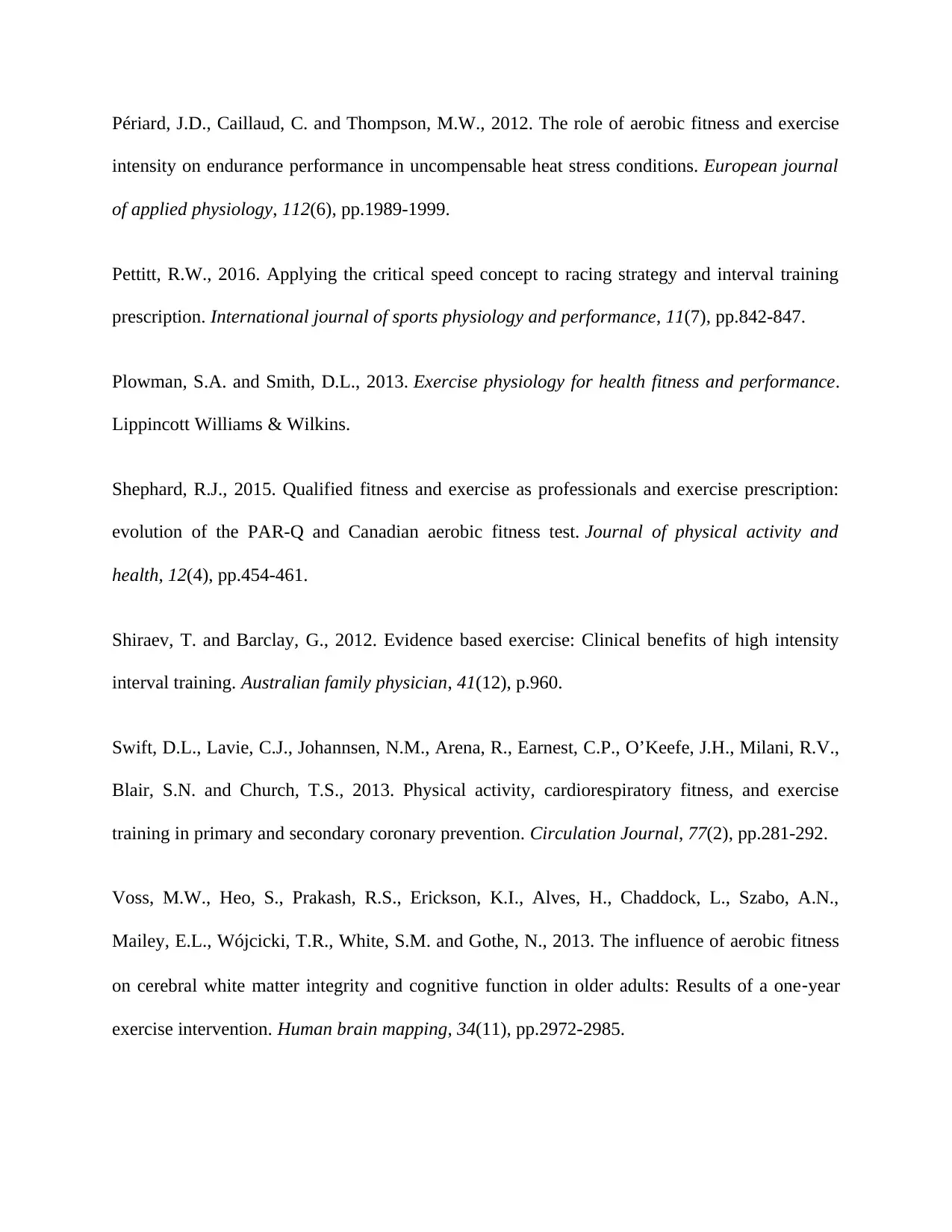APO8 Advanced Programming: Fitness, Exercise Reassessment & Diet Plan
VerifiedAdded on 2023/06/08
|3
|931
|447
Homework Assignment
AI Summary
This assignment solution for APO8 Advanced Programming addresses key aspects of fitness reassessment and client interaction. It explores factors that may limit favorable reassessment outcomes, providing explanations for their impact on measurements. Additionally, it offers detailed feedback for a client's meal timing and dietary habits, including the importance of consistent meal intervals and the potential drawbacks of skipping meals, along with considerations for basal metabolic rate. This document is available on Desklib, a platform offering a wide range of study tools and solved assignments to support students.

Bibliography
American College of Sports Medicine, 2013. ACSM's guidelines for exercise testing and
prescription. Lippincott Williams & Wilkins.
Backes, C., Leidinger, P., Keller, A., Hart, M., Meyer, T., Meese, E. and Hecksteden, A., 2014.
Blood born miRNAs signatures that can serve as disease specific biomarkers are not significantly
affected by overall fitness and exercise. PloS one, 9(7), p.e102183.
Broskey, N.T., Greggio, C., Boss, A., Boutant, M., Dwyer, A., Schlueter, L., Hans, D., Gremion,
G., Kreis, R., Boesch, C. and Canto, C., 2014. Skeletal muscle mitochondria in the elderly:
effects of physical fitness and exercise training. The Journal of Clinical Endocrinology &
Metabolism, 99(5), pp.1852-1861.
Farhat, F., Hsairi, I., Baiti, H., Cairney, J., Mchirgui, R., Masmoudi, K., Padulo, J., Triki, C. and
Moalla, W., 2015. Assessment of physical fitness and exercise tolerance in children with
developmental coordination disorder. Research in developmental disabilities, 45, pp.210-219.
Gillen, J.B. and Gibala, M.J., 2013. Is high-intensity interval training a time-efficient exercise
strategy to improve health and fitness?. Applied Physiology, Nutrition, and Metabolism, 39(3),
pp.409-412.
Hagnäs, M.J., Kurl, S., Rauramaa, R., Lakka, T.A., Mäkikallio, T.H., Savonen, K. and
Laukkanen, J.A., 2015. The value of cardiorespiratory fitness and exercise-induced ST segment
depression in predicting death from coronary heart disease. International journal of
cardiology, 196, pp.31-33.
American College of Sports Medicine, 2013. ACSM's guidelines for exercise testing and
prescription. Lippincott Williams & Wilkins.
Backes, C., Leidinger, P., Keller, A., Hart, M., Meyer, T., Meese, E. and Hecksteden, A., 2014.
Blood born miRNAs signatures that can serve as disease specific biomarkers are not significantly
affected by overall fitness and exercise. PloS one, 9(7), p.e102183.
Broskey, N.T., Greggio, C., Boss, A., Boutant, M., Dwyer, A., Schlueter, L., Hans, D., Gremion,
G., Kreis, R., Boesch, C. and Canto, C., 2014. Skeletal muscle mitochondria in the elderly:
effects of physical fitness and exercise training. The Journal of Clinical Endocrinology &
Metabolism, 99(5), pp.1852-1861.
Farhat, F., Hsairi, I., Baiti, H., Cairney, J., Mchirgui, R., Masmoudi, K., Padulo, J., Triki, C. and
Moalla, W., 2015. Assessment of physical fitness and exercise tolerance in children with
developmental coordination disorder. Research in developmental disabilities, 45, pp.210-219.
Gillen, J.B. and Gibala, M.J., 2013. Is high-intensity interval training a time-efficient exercise
strategy to improve health and fitness?. Applied Physiology, Nutrition, and Metabolism, 39(3),
pp.409-412.
Hagnäs, M.J., Kurl, S., Rauramaa, R., Lakka, T.A., Mäkikallio, T.H., Savonen, K. and
Laukkanen, J.A., 2015. The value of cardiorespiratory fitness and exercise-induced ST segment
depression in predicting death from coronary heart disease. International journal of
cardiology, 196, pp.31-33.
Paraphrase This Document
Need a fresh take? Get an instant paraphrase of this document with our AI Paraphraser

Herodek, K., Simonović, C., Pavlović, V. and Stanković, R., 2014. High Intensity Interval
Training. Activities in Physical Education and Sport, 4(2), pp.205-207.
Heyward, V.H. and Gibson, A., 2014. Advanced fitness assessment and exercise prescription 7th
edition. Human kinetics.
Korzun, D. and Gurtov, A., 2012. Structured peer-to-peer systems: fundamentals of hierarchical
organization, routing, scaling, and security. Springer Science & Business Media.
Latimer-Cheung, A.E., Pilutti, L.A., Hicks, A.L., Ginis, K.A.M., Fenuta, A.M., MacKibbon,
K.A. and Motl, R.W., 2013. Effects of exercise training on fitness, mobility, fatigue, and health-
related quality of life among adults with multiple sclerosis: a systematic review to inform
guideline development. Archives of physical medicine and rehabilitation, 94(9), pp.1800-1828.
Lewis-McCormick, I., 2015. The HIIT Advantage: High-intensity Workouts for Women. Human
Kinetics.
Lin, X., Zhang, X., Guo, J., Roberts, C.K., McKenzie, S., Wu, W.C., Liu, S. and Song, Y., 2015.
Effects of exercise training on cardiorespiratory fitness and biomarkers of cardiometabolic
health: a systematic review and meta‐analysis of randomized controlled trials. Journal of the
American Heart Association, 4(7), p.e002014.
Oh, R., 2013. Coming out of the Crossfit Closet*-A CrossFit experience by a Physician, for
Physicians. Unif Fam Physician, 7(1), pp.31-33.
Training. Activities in Physical Education and Sport, 4(2), pp.205-207.
Heyward, V.H. and Gibson, A., 2014. Advanced fitness assessment and exercise prescription 7th
edition. Human kinetics.
Korzun, D. and Gurtov, A., 2012. Structured peer-to-peer systems: fundamentals of hierarchical
organization, routing, scaling, and security. Springer Science & Business Media.
Latimer-Cheung, A.E., Pilutti, L.A., Hicks, A.L., Ginis, K.A.M., Fenuta, A.M., MacKibbon,
K.A. and Motl, R.W., 2013. Effects of exercise training on fitness, mobility, fatigue, and health-
related quality of life among adults with multiple sclerosis: a systematic review to inform
guideline development. Archives of physical medicine and rehabilitation, 94(9), pp.1800-1828.
Lewis-McCormick, I., 2015. The HIIT Advantage: High-intensity Workouts for Women. Human
Kinetics.
Lin, X., Zhang, X., Guo, J., Roberts, C.K., McKenzie, S., Wu, W.C., Liu, S. and Song, Y., 2015.
Effects of exercise training on cardiorespiratory fitness and biomarkers of cardiometabolic
health: a systematic review and meta‐analysis of randomized controlled trials. Journal of the
American Heart Association, 4(7), p.e002014.
Oh, R., 2013. Coming out of the Crossfit Closet*-A CrossFit experience by a Physician, for
Physicians. Unif Fam Physician, 7(1), pp.31-33.

Périard, J.D., Caillaud, C. and Thompson, M.W., 2012. The role of aerobic fitness and exercise
intensity on endurance performance in uncompensable heat stress conditions. European journal
of applied physiology, 112(6), pp.1989-1999.
Pettitt, R.W., 2016. Applying the critical speed concept to racing strategy and interval training
prescription. International journal of sports physiology and performance, 11(7), pp.842-847.
Plowman, S.A. and Smith, D.L., 2013. Exercise physiology for health fitness and performance.
Lippincott Williams & Wilkins.
Shephard, R.J., 2015. Qualified fitness and exercise as professionals and exercise prescription:
evolution of the PAR-Q and Canadian aerobic fitness test. Journal of physical activity and
health, 12(4), pp.454-461.
Shiraev, T. and Barclay, G., 2012. Evidence based exercise: Clinical benefits of high intensity
interval training. Australian family physician, 41(12), p.960.
Swift, D.L., Lavie, C.J., Johannsen, N.M., Arena, R., Earnest, C.P., O’Keefe, J.H., Milani, R.V.,
Blair, S.N. and Church, T.S., 2013. Physical activity, cardiorespiratory fitness, and exercise
training in primary and secondary coronary prevention. Circulation Journal, 77(2), pp.281-292.
Voss, M.W., Heo, S., Prakash, R.S., Erickson, K.I., Alves, H., Chaddock, L., Szabo, A.N.,
Mailey, E.L., Wójcicki, T.R., White, S.M. and Gothe, N., 2013. The influence of aerobic fitness
on cerebral white matter integrity and cognitive function in older adults: Results of a one‐year
exercise intervention. Human brain mapping, 34(11), pp.2972-2985.
intensity on endurance performance in uncompensable heat stress conditions. European journal
of applied physiology, 112(6), pp.1989-1999.
Pettitt, R.W., 2016. Applying the critical speed concept to racing strategy and interval training
prescription. International journal of sports physiology and performance, 11(7), pp.842-847.
Plowman, S.A. and Smith, D.L., 2013. Exercise physiology for health fitness and performance.
Lippincott Williams & Wilkins.
Shephard, R.J., 2015. Qualified fitness and exercise as professionals and exercise prescription:
evolution of the PAR-Q and Canadian aerobic fitness test. Journal of physical activity and
health, 12(4), pp.454-461.
Shiraev, T. and Barclay, G., 2012. Evidence based exercise: Clinical benefits of high intensity
interval training. Australian family physician, 41(12), p.960.
Swift, D.L., Lavie, C.J., Johannsen, N.M., Arena, R., Earnest, C.P., O’Keefe, J.H., Milani, R.V.,
Blair, S.N. and Church, T.S., 2013. Physical activity, cardiorespiratory fitness, and exercise
training in primary and secondary coronary prevention. Circulation Journal, 77(2), pp.281-292.
Voss, M.W., Heo, S., Prakash, R.S., Erickson, K.I., Alves, H., Chaddock, L., Szabo, A.N.,
Mailey, E.L., Wójcicki, T.R., White, S.M. and Gothe, N., 2013. The influence of aerobic fitness
on cerebral white matter integrity and cognitive function in older adults: Results of a one‐year
exercise intervention. Human brain mapping, 34(11), pp.2972-2985.
⊘ This is a preview!⊘
Do you want full access?
Subscribe today to unlock all pages.

Trusted by 1+ million students worldwide
1 out of 3
Your All-in-One AI-Powered Toolkit for Academic Success.
+13062052269
info@desklib.com
Available 24*7 on WhatsApp / Email
![[object Object]](/_next/static/media/star-bottom.7253800d.svg)
Unlock your academic potential
Copyright © 2020–2025 A2Z Services. All Rights Reserved. Developed and managed by ZUCOL.
